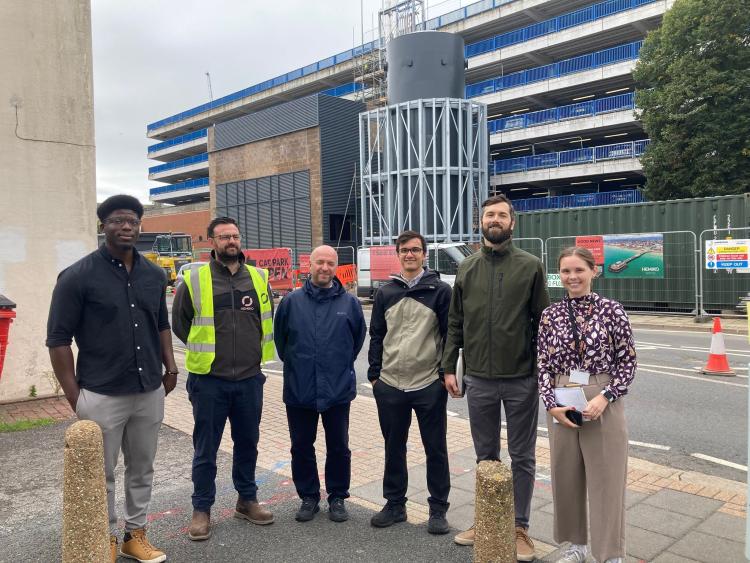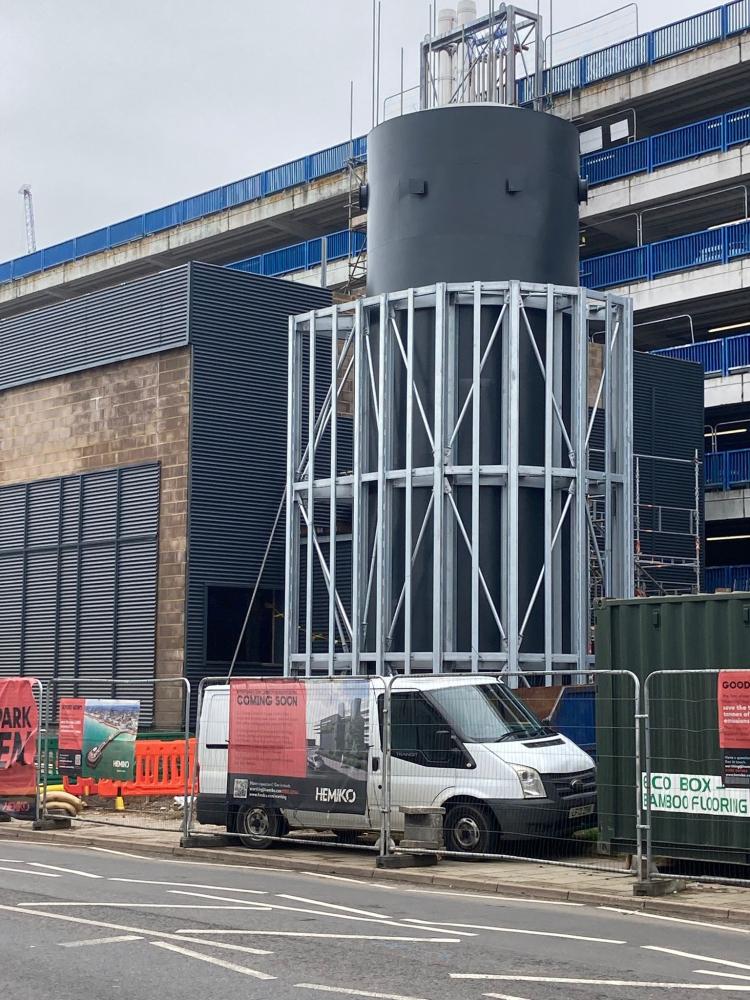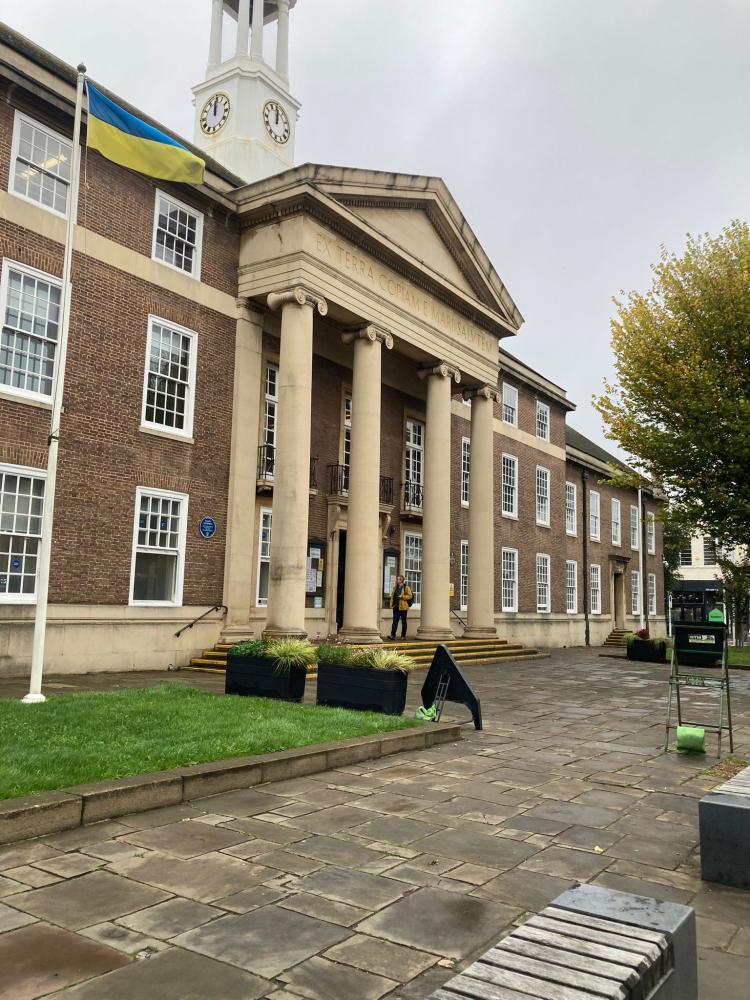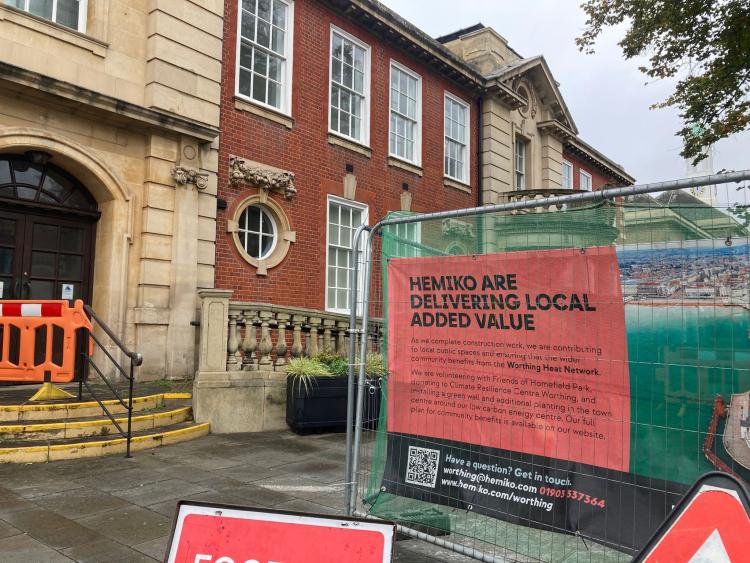Historic sites come face to face with innovative technology designed to create better places for local people
Worthing community sees listed buildings brought into the 21st century thanks to Public Sector Decarbonisation Scheme
State-of-the-art energy efficiency technology is transforming some of Worthing’s most treasured listed buildings as part of an ambitious net zero project.
Adur & Worthing Councils is harnessing the Public Sector Decarbonisation Scheme to connect a series of historic and much-loved sites - including Worthing Town Hall, the Connaught Theatre & Studio, and Worthing Museum - to the Worthing Heat Network.
The scheme is ensuring that heritage assets are preserved while being future-proofed for generations to come.
Our team visited the project to talk to the people who are driving the challenging scheme.

From left: Fouad Amuni (Salix), Christopher Horner (Hemiko), Davide Natuzzi, Justin Morris (Salix), Matt Nixon (Adur & Worthing Councils) and Sarah Glaser (Hemiko). They are pictured outside the energy centre
Photo credit: Salix Finance
It’s fascinating to see how six very important buildings are now being connected to the privately funded heat network.
It’s a great example of how successful partnerships can work when driving our net zero ambitions.
The tour, which began at Worthing Town Hall, included a walk through the busy town centre to the energy centre via the civic centre and historic Connaught Theatre & Studio.
These buildings are being connected to the low-carbon heat network, which will replace reliance on ageing gas boilers with a steady, sustainable supply of energy.
The project team highlighted the complexities of installing modern infrastructure in a thriving town, balancing the need to maintain traffic flow and support local businesses with delivering long-term environmental benefits.
Council project manager Matt Nixon explained how the team had to be sensitive to the history of the buildings but also recognising the need to modernise and future-proof them for the decades ahead.
He also explained the issues in Worthing, largely around operating in a busy town centre in buildings that are heavily used.
Joining the tour were Salix colleagues Davide Natuzzi, Justin Morris and Fouad Amuni. They met with Matt Nixon from the council and Christopher Horner and Sarah Glaser from contractors, Hemiko.
Davide said: “Heat networks are not new, but they can be complex, and this is a fascinating project.
“It’s interesting to see how the work is happening in full sight and whilst the public are moving around it. It’s a mammoth logistical task with big ambitions.”
Our programme co-ordinator Justin Morris added: “It’s fascinating to see how six very important buildings are now being connected to the privately funded heat network.
“It’s a great example of how successful partnerships can work when driving our net zero ambitions.”

The energy centre in Worthing
Photo credit: Salix Finance
The council secured £2 million under Phase 3b and £5.6 million under Phase 3c of the Public Sector Decarbonisation Scheme to deliver the work.
Phase 3b funding is being used to connect the Grade II listed Town Hall and Worthing Assembly Hall, along with Portland House and the Connaught Theatre & Studio. The Connaught, one of the UK’s oldest cinemas, remains a vital cultural hub and community space.
The Connaught Theatre is one of UKs oldest cinemas and is a busy hub of activity. Local people are passionate about this community space.

From left: Matt Nixon (Adur & Worthing Councils), Justin Morris (Salix), Christopher Horner (Hemiko), Fouad Amuni (Salix), Sarah Glaser (Hemiko), and Davide Natuzzi (Salix). They are pictured outside the Connaught Theatre
Photo credit: Salix Finance
As part of the upgrades, each building is undergoing fabric and distribution system improvements before being connected to the district heat network. Measures include loft insulation, double and secondary glazing, draught proofing, solar PV, and LED lighting. This phase, costing a total of £3.4 million, is expected to deliver carbon savings of 219.69 tonnes annually and will be completed by March 2026.
The fabric works mean the heat from one of the lowest carbon heat networks in the UK will have more impact.
Meanwhile, Phase 3c funding is supporting connections for additional sites: Worthing Museum is due to connect later this year, whilst Splashpoint and pavilion are due to connect in the next phase of the network.

Worthing Town Hall is being connected to the heat network
Photo credit: Salix Finance
The pavilion and museum will undergo similar fabric improvements before connection, while Splashpoint – due to its high energy demand – requires minimal adaptation but represents a significant link to the network. This phase is expected to cost £6.4 million and achieve annual carbon savings of 609.97 tonnes.
The council says Splashpoint requires minimal adaptation work but is a substantial connection due to the heat demand on site.
Together, the projects are helping Adur & Worthing Councils achieve their target of becoming carbon neutral in their own operations by 2030, while supporting the wider UK100 pledge to reach net zero across Adur and Worthing by 2045.
Community benefits
The works have created 48 local jobs and generated strong community interest - even inspiring a local bakery to name a new product the ‘Hemiko bagel’ in honour of contractors Hemiko, who are leading the installations.
Project manager at contractors Hemiko and Worthing native Christopher Horner, is delighted with progress so far.
He said: “These works mean the heat from one of the UK’s lowest-carbon heat networks will deliver maximum benefit to the community while protecting valued heritage buildings.
“There is inevitably some disruption, but by working closely with residents, shopkeepers, and transport providers, we’re making sure to deliver a greener, cheaper future for Worthing.”
The project has not been without surprises - with unexpected challenges coming when Hemiko assisted the Royal Navy with machinery to remove a suspected World War II ammunition on Worthing Beach; this turned out to be a gas canister.
Despite this, the scheme remains on track and continues to showcase how innovation and heritage can work hand-in-hand.

The popular museum has had to close during works, where communication has been key to success
Photo credit: Salix Finance
Thank you to Adur & Worthing Councils for hosting our team and showcasing the Worthing Heat Network project.




